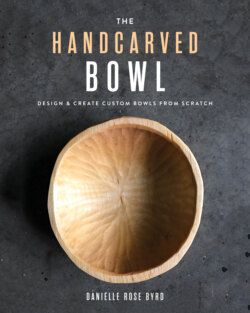Читать книгу The Handcarved Bowl - Danielle Rose Byrd - Страница 55
На сайте Литреса книга снята с продажи.
Оглавление55
T H E H A N D C A R V E D B O W L
Chapter 3 | S H A R P E N I N G
It is common for diamond
stones to cut more aggressively
than their nominal grit would
suggest, at least at first. They need
a bit of a break-in period to cut
at their intended rate, but should
remain consistent for some time
after this point has been reached.
WATERSTONES
Waterstones (I) are a popular
choice for plane blades, but are a
bit more difficult to use on curved
edges. As you may have guessed,
they use water as a lubricant so
tools should be dried and wiped
down with an oiled cloth after each
sharpening to avoid rust. They
are friable, meaning they wear
away to expose a fresh cutting
surface, making them efficient.
They should be either stored in
water or soaked before using, but
can also freeze and crack if left in
an unheated shop. I use Ohishi
waterstones that are dense enough
that they don’t have to be soaked,
and need only a spray of water
before use.
Easy to Gouge
It can be fairly easy to gouge wa-
terstones with curved blades. The
result is that you have to remove
a considerable amount of material
from the stone in order to re-lap
(flatten) it to remove the nick.
I know there are carvers out
there who use waterstones, but
they can be challenging
for beginners and
tend to be less ap-
proachable in both
upkeep and cost.
If you already
have them around,
they may be your
first choice. A
waterstone is used to
address the bevel side
of the tool edge; the
burr on the inside of
the curve is tackled
by a slipstone, which
is a waterstone with a curve, just
like using the dowel with abrasive
paper. Slipstones can be purchased
or custom made. If you acciden-
tally drop a waterstone, use the
pieces to shape custom profiles.
WATER BATH GRINDERS
Water bath grinders (J) are a
popular option for hollow grinding
because they turn a wheel at slow
speed through a water bath, mak-
ing it very difficult to overheat the
tool edge, which can damage the
steel’s structure and make it weak.
They can be outfitted with both
a grinding wheel and a buffing/
stropping wheel. There are jigs that
assist with curved-edge tools, but a
freehand technique affords better
results. They are, of course, useful
for sharpening many other tools.
Relative to bowl carving tools,
these systems are most useful for
quickly and accurately changing
bevel angles or sharpening many
J
I
